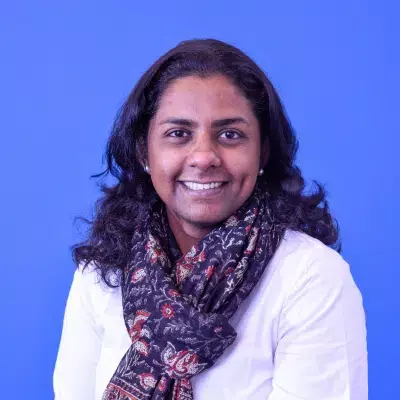At Grow Further, we “Empower farmers, scientists, and individuals to create a food-secure future.” Our members and network of agricultural researchers–550 of whom responded to our first call for proposals–are of course central to achieving this mission. But there are also many people working behind the scenes, including our board of directors.
Meet Board Member Suvasini Ramaswamy
When she joined our board, Suvasini Ramaswamy was a project leader with Boston Consulting Group. She now works at the Bill & Melinda Gates Foundation. A scientist in her own right, Ramaswamy brings a background in molecular biology and cancer research—she holds an M.S. in plant molecular biology from the University of Delhi and a Ph.D. in molecular oncology from the Indian Institute of Science. Her career passion led her to the United States to work in medical research, eventually broadening her horizons through work in management consulting. That path eventually led her to Grow Further’s board.
Ramaswamy graciously took time out of her busy schedule for an interview. Below, she shares with us a few more details about her impressive background, her career in science, and her first introduction to and impressions of Grow Further.
Suvasini Ramaswamy, in her own words
Q: Could you tell us a little bit about your background?
A: I grew up in India fascinated by trying to understand the “why” and “how” behind things. Reading an essay about Marie Curie as part of my early education really inspired me to become a scientist. I pursued that dream and studied botany in my undergraduate program.
I then applied to a prestigious national fellowship program and got an opportunity to spend my summer working at the Indian Institute of Science in molecular biology. I worked on yeasts (Candida and Saccharomyces) to identify antifungal plant extracts. This experience opened up a whole new world for me as I used many molecular biological tools for the first time and truly understood their power.
This led me to pursue a Master’s program in plant molecular biology.
Q: Where did your path in science take you next?
A: My Master’s thesis involved screening a library of synthetic promoters in Arabidopsis (the ‘model system’ for much of plant research) for being able to drive tissue-specific gene expression. This was a challenging project for many reasons—chief among them was perhaps the fact that the world of plants operates at much slower timelines.
After successfully completing that project, I decided to pursue my Ph.D. in something more translational and with some more immediate impact on people’s lives. This brought me to the Indian Institute of Science where I worked in molecular oncology. I worked to understand the molecular underpinnings of a highly lethal form of brain cancer called glioblastoma.
My Ph.D. was an interesting experience: I learned a lot about cancer biology, the power of in-vitro research, and learned to work with complex animal model systems to study human diseases like cancer.
That said, academics in India was slow, somewhat patriarchal, and political. My passion for science and problem-solving was still strong, and so I did my “control” experiment and moved to the U.S. to work at the Salk Institute in San Diego.
“A platform whereby non-specialists could contribute to and engage with projects in agricultural innovation was interesting”
Q: After you landed in the United States, where did your career take you next?
A: Here, I wanted to learn something new and work on something more cutting-edge. A confluence of fortuitous events led me to working in a research lab using new modalities like cell and gene therapy to treat genetic disorders of the liver. I was working on mRNA therapies for treating hemophilia in the years leading up to COVID, so really cutting-edge stuff.
That said, academic research in the U.S. was plagued by funding challenges. I also realized that research was fundamentally about going deeper and deeper in a very narrow space, which was less exciting to me. I loved breadth and enjoyed learning about widely different topics. The ability to make a meaningful impact that had always motivated me also felt distant as research was mostly about incremental advances and publications, even when it was translational.
That realization, a lot of self-reflection, and some other coincidences led me to management consulting at [Boston Consulting Group].
My time at BCG allowed me to work broadly across the healthcare and life sciences sectors. It was a transformative experience unlike any other.
Q: How did you first connect with Peter (Grow Further’s founder and president)?
A: My first interaction with Peter was via LinkedIn in 2019 when he sent me a message requesting some input on the business plan for Grow Further. This was a completely random outreach and we had no common connections. At that time, I was busy working upwards of 70-hour weeks at BCG, but this proposition of working in ag-tech to solve the food crisis intrigued me.
We connected via phone call, and I really appreciated Peter’s candid and transparent style. He shared with me his vision for Grow Further, and I thought it was an intriguing idea.
— Grow Further
Photo: Grow Further Board Member Suvasini Ramaswamy.




